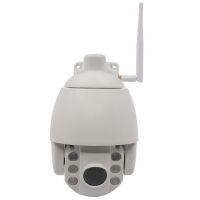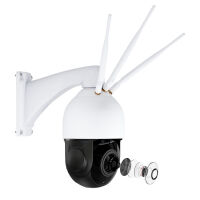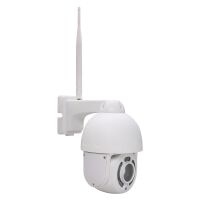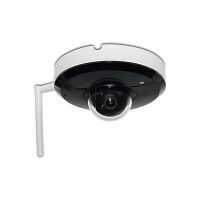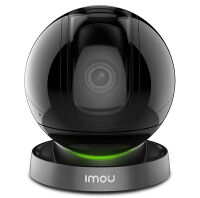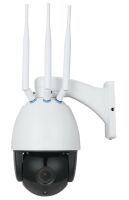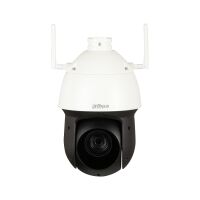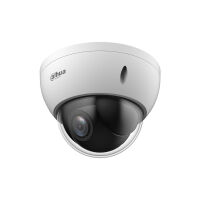PTZ cameras
With a PTZ surveillance camera that can pan and tilt, a very large surveillance area can be covered.
In addition, these surveillance cameras also have zoom lenses to zoom in on more distant objects.
What is a PTZ camera?
Pan and tilt security cameras are commonly referred to as PTZ cameras. Here, the name speed domes has established itself due to the sometimes very high rotational speed of up to 400° / second.
For the abbreviation PTZ, the P stands for Pan, so pan, T for tilt as tilt and Z for zooming.
This type of surveillance camera is often used outdoors to protect large areas that can not be covered by simple, static cameras unless larger numbers are used. Especially the use of these speed domes requires special attention in the planning, as there are an unmanageable number of models.
PTZ surveillance cameras monitor large areas that would require a whole range of static cameras. In addition, these cameras work with zoom lenses of up to 30x optical magnification.
Such PTZ Domes are controlled with an external keyboard or with the mouse on the PC via a video management solution. Cameras that have an app can also be easily rotated, tilted and zoomed on the smartphone.
By now, most PTZ cameras have built-in IR LEDs with ranges of up to 300 meters. The advantage is that it eliminates the need for external IR LED spotlights, and the spot of the IR spotlight illuminates exactly where the PTZ Dome looks.
A big disadvantage are insects in the summer months, which are attracted by the IR light (frequency around 850nm, light, reddish glow). Since the IR LEDs are mounted close to the lens, the visibility will be compromised and the night shots may be unusable. So if a good result is to be achieved in the summer nights, and if a video analysis is used, you can not get around a separate IR LED spotlight.
Many of the offered PTZ cameras offer so-called tours, also called "patrol", which the dome departs in a certain time frame. During setup, presets are input, which are the dome's views. These preset positions are now automatically lowered by the dome, staying for a certain time and then moving to the next position. The presets are also linked to the zoom factor, so the individual positions are also assigned the zoom setting.
Of course, this procedure has the disadvantage that not all directions can be observed simultaneously. Here are several static cameras that monitor every part of the area, their advantage. But there are also interesting solutions for using the static cameras in combination with rotatable systems.
What is the difference at PTZ cameras?
There is a wide range of rotating surveillance cameras, from small bullet or dome versions that move slowly, to speed domes that rotate up to 400 degrees per second.
Optical zoom:
Whether 3x or 30x zoom - it depends on the application and on the budget. The speed domes have the 25x or 30x magnifications established. For identification, it is often necessary to use a 30x optical zoom (recognize faces and details, read license plates and labels). A high-quality lens, which increases 30 times, of course, also reflected in the price. Here you go best the golden middle ground.
Image Resolution:
From 2MP (FullHD) to 8MP (4K) everything is included. If I have already decided for a PTZ dome with 30x magnification, should be enough 2MP (FullHD) actually. Of course, an 8MP picture looks more brilliant and also brings up the smallest details, but also requires four times as much processing power for the processing, presentation and storage of video data.
Built-in IR LEDs (night vision):
There are only a few models without built-in IR LED's. The performance of these LEDs reaches considerable distances of up to 300 meters, with the manufacturers giving their information very optimistically. We usually adapt this data to our own experience, which averages 70% of the manufacturer's information.
Designs:
Speed domes and most PTZ cameras in use are dome cameras, ie dome versions. Smaller PTZ cameras are also predominantly dome versions, but there are also quite a few bullet versions here. Especially in the outdoor area, these bullet versions have proven themselves, because it does not come to the feared light reflex with which the dome cameras have to fight in the sunlight.
The size may also play a role: if it is a discrete surveillance, a Minidome is preferred. In professional installations, this plays a minor role, since the domes are mounted at least 4 - 5 meters high and visibility is desired.
Transmission technology:
LAN cable connection:
The usual, also in the professional field applied transmission of the video signal is the wired technology via coax cable or network cable. This form of transmission is very safe and reliable, which is a prerequisite for industrial applications. The PTZ outdoor surveillance camera as an analog or IP camera can be operated over long distances. By default, distances of up to 300 meters (for higher-quality cables up to 800 meters) and swiveling outdoor IP cameras of up to 100 meters are considered for transmission via coax cable, whereby 80 meters should not be exceeded for secure transmission. So-called LAN extenders, which are interposed, can realize distances of up to 2.5Km.
WLAN connection:
Another type of transmission is WLAN, which is very popular in the private sector due to the simple installation (no cable routing necessary). PTZ WLAN IP cameras are used here and connected to a WLAN router. If the distance between the WLAN router and the swivel-mounted WLAN surveillance camera is too long, WLAN repeaters can be used.
Within buildings, a maximum distance of 10 - 20 meters should be expected, outside buildings up to 30 meters. However, this information can vary greatly depending on the nature of the partitions.
3G LTE mobile with SIM card:
If there is no network and no Internet connection via a router, the video streams of a PTZ camera can also be transmitted with LTE connections. The PTZ IP Camera is operated with a SIM card that transmits the video data to a mobile network of an LTE 3G provider. The cost of a transfer is very transparent: we assume data usage of 1GB per month when the video stream is sent for about 5 minutes per day. This is enough for our experience to check every day to see if everything is alright. A very useful feature is the motion detection, which pushes a message on your smartphone, so you can immediately view the live data.
Tours:
The ability to set different presets, ie positions that the PTZ camera moves off at intervals, is one of the most important features of a PTZ camera. So I have covered, albeit not simultaneously, but many angles offset in time. It does not necessarily have to be 150 presets, but at least 4 positions would be important. These positions can either be traversed automatically, or they can be selected by pressing a button.
Auto Tracking:
A very interesting feature of PTZ cameras is the autotracking: This means an automatic tracking of objects. The camera is in the home position with the lens zoomed out. When a person or vehicle is detected, the camera tracks that object and zooms in, depending on the speed of the object. If the tracked object leaves the detection range of the PTZ camera, the dome returns to its original position.
Mechanics:
PTZ surveillance cameras, which are occasionally moved, do not require the same mechanical conditions as a dome, which departs presets every day or is constantly moved in the store by security personnel. Accordingly, the requirements and also the price.
Do I need a swiveling surveillance camera or is a standard camera enough?
For the surveillance of smaller areas with the desired result that objects are detected, standard cameras should be sufficient. Here it makes sense to work with larger resolutions (5MP instead of 2MP Full HD). When larger areas need to be monitored, or when it comes to identifying objects (detecting faces, reading license plates), and the distances are greater, either several standard cameras or a PTZ camera with a zoom lens can be used. It has to be considered that the acquisition of PTZ cameras and speed domes only make sense if they actively intervene in the control, whether with a control panel, with a mouse via a VMS solution or with an app on the smartphone. A few years ago we carried out a survey and asked users of professional equipment about the use of speed dome with the result that almost 70% of all cameras in operation are no longer moving.
Conclusion: Panning, tilting cameras, PTZ cameras and speed domes are both very effective and important parts of the surveillance concept when it comes to the right planning and design. The price of a good PTZ camera is 3 to 10 times of a standard camera. This extra charge is justified in any case with a PTZ Dome and today's features, provided that you also use them.
If you plan a video surveillance for your house, warehouse, shop or land, we are happy to assist you in choosing the right technology. We advise you free of charge, objectively and without obligation: Call us on 02433/964 25 80 or send us an e-mail to service@blick-store.de. We are looking forward to your contact!


